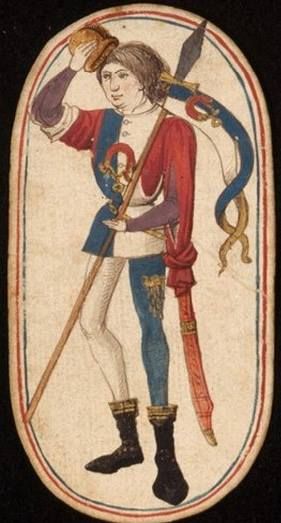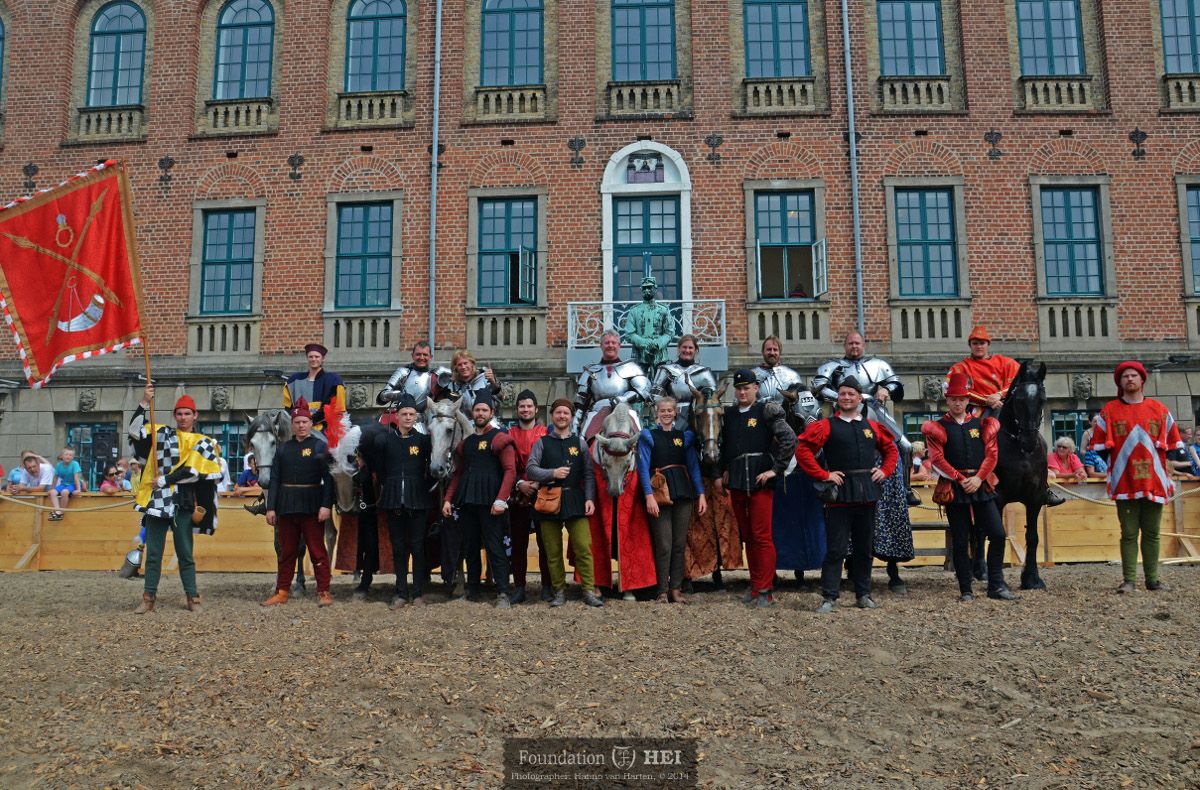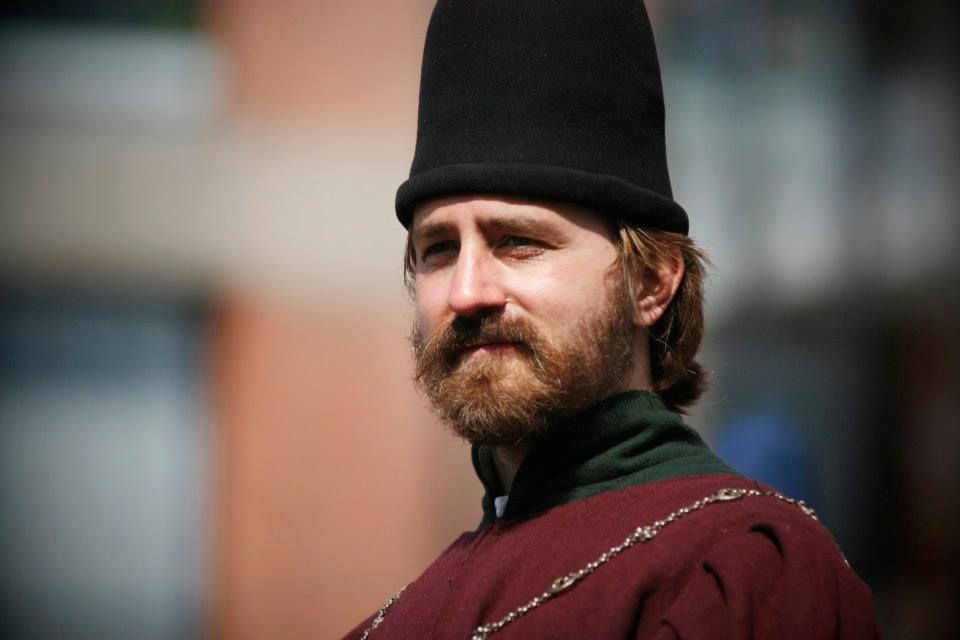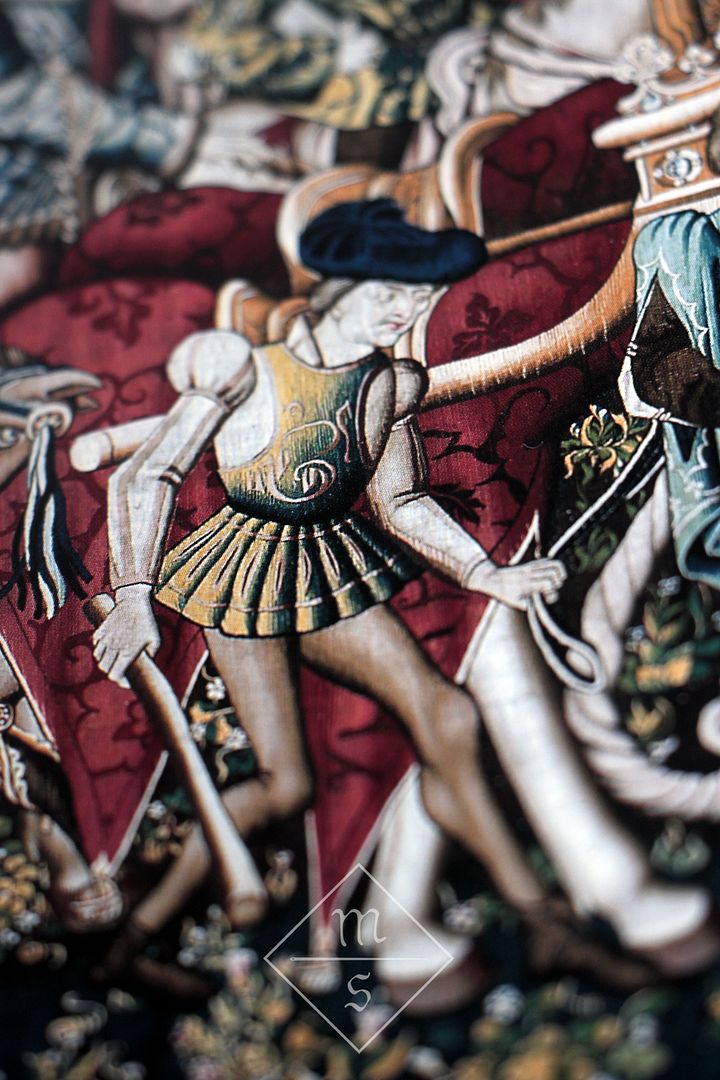Foundation HEI(or Stichting HEI in their native Dutch) was founded in 2000 by a group of people with a love for history. They work together to create historically accurate jousting tournaments and other historical displays in an attempt to share their love of history with the public.
 An important part of their tournaments and displays is the clothing worn by the participants, not just the jousters and heralds who are predominantly featured during tournaments, but also the so very important, but often overlooked, ground crew. For the 2014 jousting season, Foundation HEI fulfilled one of their long term goals of creating historically accurate custom journeyen for the members of their ground crew. The historic description of journeyen is "tunica sine manicis", meaning tunics without sleeves.
An important part of their tournaments and displays is the clothing worn by the participants, not just the jousters and heralds who are predominantly featured during tournaments, but also the so very important, but often overlooked, ground crew. For the 2014 jousting season, Foundation HEI fulfilled one of their long term goals of creating historically accurate custom journeyen for the members of their ground crew. The historic description of journeyen is "tunica sine manicis", meaning tunics without sleeves.
(Right: detail from Set of Fifty Two Playing Cards, c1470-1480, South Netherlandish, Metropolitan Museum of Art)
The journeyen made their debut at Stichting HEI's annual White Bear Tournament at Nyborg Slot. The tournament is named after the White Bear fraternity, which was the company of Bruges patricians that organised a joust in the great market square of Bruges every year around May during the late fourteenth to late fifteenth century. The jousting troupe at HEI is designed to emulate the knights from Bruges, using the members of the White Bear's heraldry for their own jousting troupe's heraldry and the crowned letter B(which is the medieval logo of Bruges) as the logo on their journeyen.

The jousters, heralds and ground crew(in their journeyen) at the Nyborg 2014 White Bear Tournament(photo by Hanno van Harten)
When asked about the journeyen, Bertus Brokamp, Voorzitter(which is Dutch for Chairman) of Stichting HEI, gave the following statement:
The decision to have the journeyen made was based on historical statements describing the clothing worn for tournaments. The following three quotations(with English translations) are examples:
The first is from a description of the tournament that Maximilian (not yet Holy Roman emperor since his father was still alive, but already count of Flanders since he had married Mary of Burdundy) held in 1482 in Bruges. The source is Het boeck van al 't gene datter geschiedt is binnen Brugghe (The book of all that has happened in Bruges) which describes things that happened in Bruges between the years 1477-1491.
Research and overall coordination of the project: Bertus Brokamp (Coronael)
Overall design: Bertus Brokamp (Coronael) & Isis Sturtewagen (Medieval Silkwork)
Fitting of patterns to each individual groundcrew member: Isis Sturtewagen (Medieval Silkwork) & Bertus Brokamp (Coronael)
Making of the Embroidered Badges: Badge of Honour from India
Sewing of the Journeyen: Gabriela Glinianowicz (Amictus)
Isis Sturtewagen, who helped design and pattern the journeyen, wrote an informative article about their creation on her blog, Medieval Silkwork:
About a year ago I fitted the patterns for twenty two journeyen, 'tunica sine manicis' or sleeveless tunics in one afternoon. I have never had so many men in my hands in such a short time slot ever before, I can tell you. These journeyen were for the ground crew of Foundation Historic Educational Initiative (short: HEI) for their jousting display.
Thanks to Bertus Brokamp's research (the chairman of the foundation and accidentally also my boyfriend) I didn't have to do much else but pick my favourite example and recreate that. Bertus included a wide array of sources in his report, from written accounts to paintings, playing cards, and tapestries. I really liked the button closure on the playing card journeyes and the pleated skirt of the journeye on the tapestry above.
....
To read the rest of the article, which includes several more pictures, click here.
Related articles:
Stichting HEI Posts about the White Bear Tournament in Nyborg Slott
Wouter Nicolai Describes His Experiences Doing a 'Joust at Large'
Teaser Video Shows Off the Jousters of Foundation HEI
Vera Bos Talks about Her Upcoming Documentary "The White Bear"
"By means of shows and demonstrations, we want to make our spectators feel and see for themselves how life may have been in times past." – Stichting HEI Facebook
 An important part of their tournaments and displays is the clothing worn by the participants, not just the jousters and heralds who are predominantly featured during tournaments, but also the so very important, but often overlooked, ground crew. For the 2014 jousting season, Foundation HEI fulfilled one of their long term goals of creating historically accurate custom journeyen for the members of their ground crew. The historic description of journeyen is "tunica sine manicis", meaning tunics without sleeves.
An important part of their tournaments and displays is the clothing worn by the participants, not just the jousters and heralds who are predominantly featured during tournaments, but also the so very important, but often overlooked, ground crew. For the 2014 jousting season, Foundation HEI fulfilled one of their long term goals of creating historically accurate custom journeyen for the members of their ground crew. The historic description of journeyen is "tunica sine manicis", meaning tunics without sleeves. (Right: detail from Set of Fifty Two Playing Cards, c1470-1480, South Netherlandish, Metropolitan Museum of Art)
The journeyen made their debut at Stichting HEI's annual White Bear Tournament at Nyborg Slot. The tournament is named after the White Bear fraternity, which was the company of Bruges patricians that organised a joust in the great market square of Bruges every year around May during the late fourteenth to late fifteenth century. The jousting troupe at HEI is designed to emulate the knights from Bruges, using the members of the White Bear's heraldry for their own jousting troupe's heraldry and the crowned letter B(which is the medieval logo of Bruges) as the logo on their journeyen.

The jousters, heralds and ground crew(in their journeyen) at the Nyborg 2014 White Bear Tournament(photo by Hanno van Harten)
When asked about the journeyen, Bertus Brokamp, Voorzitter(which is Dutch for Chairman) of Stichting HEI, gave the following statement:
"At HEI, we want to portray history as accurately as possible. This means the clothing must look good and fit the station or work environment. So when we discovered, more then ten years ago already, that our groundcrew needed to wear sleeveless 'livery coats', as we called them back then, we aimed to give them these. When I became chairman, I took this task upon myself. So after the projects of implementing the White Bear theme, getting new banners and getting the heralds' coats of arms were completed, the journeyen (as we found out was their proper Middle Dutch name) had to be made.
Of course, not only the type of fabrics were important for the look (Bruges was THE most wealthy trading hub in Western Europe), but also the fit of the clothing was important. Each journeye[the singular form of journeyen] must fit each individual wearer and give him the typical mid fifteenth century silhouette of broad shoulders and a defined waist. This meant making a tailored pattern for each groundcrew member. A lot of work, but in the end we do believe it shows. It makes the team visually come together. A team that we highly value for their hard work. Providing them with high quality clothing therefore is one of our ways of saying thank you!" – Bertus Brokamp, Chairman Foundation HEI
The decision to have the journeyen made was based on historical statements describing the clothing worn for tournaments. The following three quotations(with English translations) are examples:
The first is from a description of the tournament that Maximilian (not yet Holy Roman emperor since his father was still alive, but already count of Flanders since he had married Mary of Burdundy) held in 1482 in Bruges. The source is Het boeck van al 't gene datter geschiedt is binnen Brugghe (The book of all that has happened in Bruges) which describes things that happened in Bruges between the years 1477-1491.
"ende alle die doe daer waren ... hadden alle an journeyen, naer der steickbane manieren, al van den zelven lakene"The second is a quote from the household accounts of Charles the Bold, taken from the pages where the expenses are listed for his wedding in 1468 in Bruges. This was celebrated with the most famous Tournament of the Golden Tree, or l'Arbre d'Or in French, organised by his half brother, Anthony the Great Bastard of Burgundy.
translation: "and all who were there, ... all were wearing journeyen, after the tiltyard manner, all of the same cloth"
"pour douze journades faites ... pour luy en servir aux joustes de ses nopces, sur lesquelz il a miz et assiz 23 marcs et demi d'argent et fait sur chascune de broudure le fuzil et la devise de monseigneur avec les flammes profillees d'or,"The third quote is about the battle of Brustem in 1467, of Charles the Bold against Liege, where also 200 soldiers of Bruges were present. It's source was Cronijcke van den lande ende graefscepe van Vlaenderen (Chronicle of the Land and County of Flanders)
translation: "for twelve journeyen, made ... for those who were to serve at the jousts of his wedding, for which were given 23,5 marcs of silver and made with on each embroidery the sigil and motto of my lord with the flames in profile of gold"
"mids der hulpe ... van joncheer Pieter Metteneye, ... die beleedere van de IIc Brugghelinghen, die welcke insghelijcx ooc alleghadere nieuwe journeyen an hadden ..., met eender ghecroonder B voren ende achtere"The actual creation of the Foundation's journeyen was the work of several different people:
translation: "with the help ... of squire Pieter Metteneye, ... the leader of the two hundred Brugians, who all were wearing new journeyen ..., with a crowned B on the front and back"
Research and overall coordination of the project: Bertus Brokamp (Coronael)
Overall design: Bertus Brokamp (Coronael) & Isis Sturtewagen (Medieval Silkwork)
Fitting of patterns to each individual groundcrew member: Isis Sturtewagen (Medieval Silkwork) & Bertus Brokamp (Coronael)
Making of the Embroidered Badges: Badge of Honour from India
Sewing of the Journeyen: Gabriela Glinianowicz (Amictus)
Isis Sturtewagen, who helped design and pattern the journeyen, wrote an informative article about their creation on her blog, Medieval Silkwork:
About a year ago I fitted the patterns for twenty two journeyen, 'tunica sine manicis' or sleeveless tunics in one afternoon. I have never had so many men in my hands in such a short time slot ever before, I can tell you. These journeyen were for the ground crew of Foundation Historic Educational Initiative (short: HEI) for their jousting display.
Thanks to Bertus Brokamp's research (the chairman of the foundation and accidentally also my boyfriend) I didn't have to do much else but pick my favourite example and recreate that. Bertus included a wide array of sources in his report, from written accounts to paintings, playing cards, and tapestries. I really liked the button closure on the playing card journeyes and the pleated skirt of the journeye on the tapestry above.
....
To read the rest of the article, which includes several more pictures, click here.
Related articles:
Stichting HEI Posts about the White Bear Tournament in Nyborg Slott
Wouter Nicolai Describes His Experiences Doing a 'Joust at Large'
Teaser Video Shows Off the Jousters of Foundation HEI
Vera Bos Talks about Her Upcoming Documentary "The White Bear"



No comments:
Post a Comment